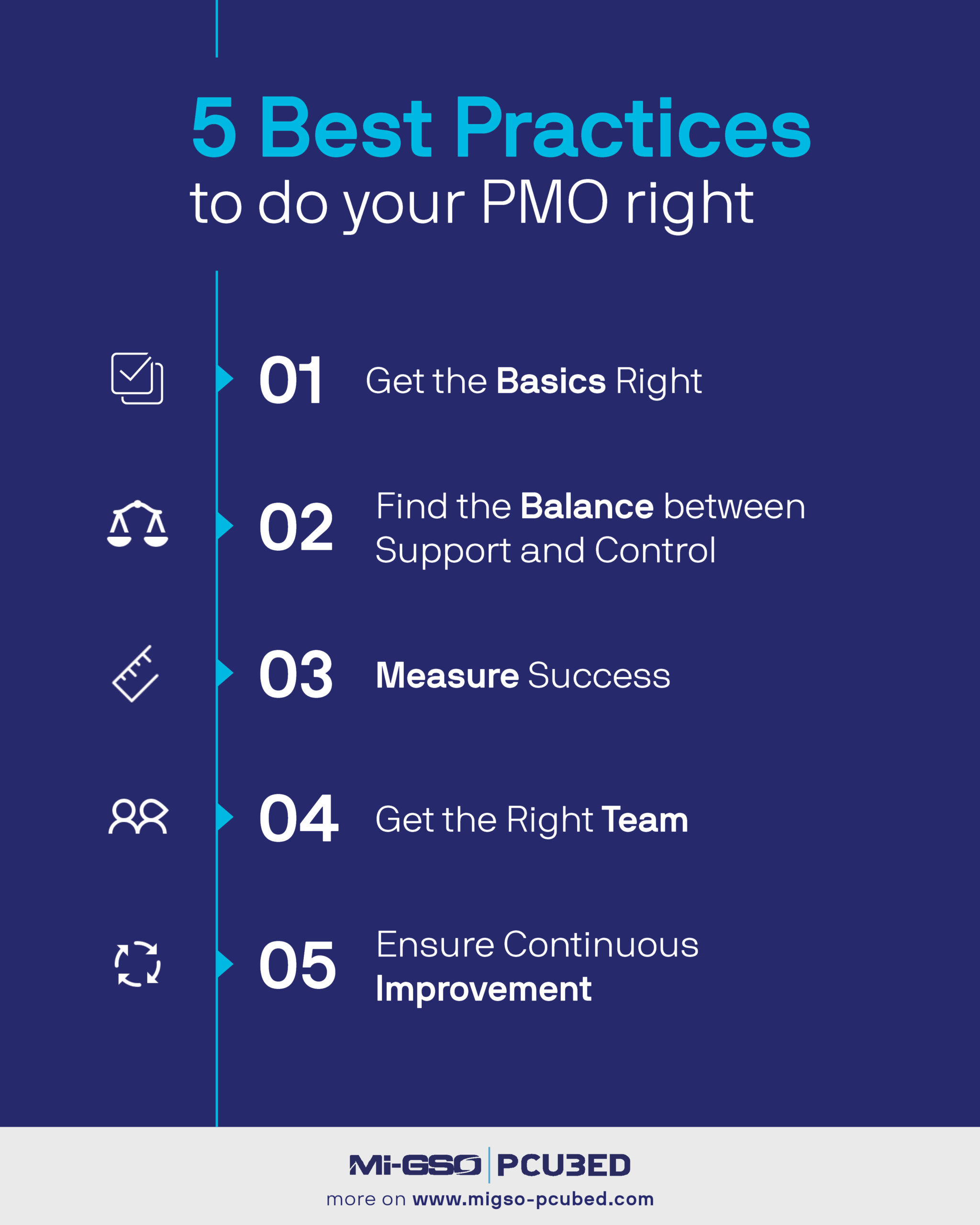Our website is not supported on this browser
The browser you are using (Internet Explorer) cannot display our content.
Please come back on a more recent browser to have the best experience possible

Large, complex programs are inherently difficult. Keeping a large team on task, often spanning multiple departments, countries, and hundreds of resources, requires huge amounts of discipline and dedication. A great program management office (PMO) can be the make or break mechanism to ensuring project value is delivered. When done right, this key to discipline will address issues before they occur. When things go wrong (as they always do), your PMO is the key to provide the data and insights to make the right decisions to get back on track.

Here are the five rules for how to achieve a great PMO.
While most people today would agree that the PMO is beneficial, most within an organization have differing views on what value a PMO actually provides. Nearly every organization has a slightly different PMO – enterprise PMO, Center of Excellence, Agile, Hybrid, Lean. You name it, we’ve seen it.
However, the key to a great PMO is to ensure that, while tailoring for an organization, you do not stray too far away from the basics. The primary role of the PMO is to ensure the delivery of value to the organization through enhanced visibility and effective governance.
Read more: How to Setup a PMO
What if the PMO utilized a more efficient approach? At MIGSO-PCUBED, we call this the Lean PMO. Our consultants consistently look for ways to streamline processes and tools, reduce waste, and improve satisfaction, all while still meeting expectations.
Finally, rather than leave it to chance, we spend time with key stakeholders to gain agreement around what the PMO’s objectives are, how the team is structured, and various other responsibilities.

It’s quite common for an immature PMO to act simply as an administrative function, providing data used to generate various reports. However, if all you focus on is being an ultimate body of control, then there’s not much value. You’re just seen as policing rather than making anything happen.
The PMO provides the glue that integrates a bunch of disparate efforts… so you can make sense of what is in flight and make strong decisions on what to do next.
From our insight article PMO Maturity Model: Is your PMO Ready for what’s Next?
In a great PMO, the teams help project managers with their plans, run workshops with stakeholders to identify which initiatives are aligned to strategy and which initiatives are merely pet projects, and work with the organization to identify solutions to problems.
However, in order to do all of that, you need to have enough time. If you’re too busy acting as an administrator, writing reports, or adding tasks to project schedules, then you’ll have no time to do things you should be doing, like analyzing data.
That means you’ve got to be able to say “No,” because you can’t do everything. The first key enabler is your alignment with stakeholders on the role of the PMO. The second key enabler – remember the Lean PMO?
A great PMO will focus on establishing repeatable processes, automating manual tasks with workflows, and creating real-time dashboards – thereby giving the team more time to focus on higher value add activities.
You need to find the right balance of asking people for status updates while also providing them the right amount of support with good processes, structure, and issue resolution to be of a benefit to them. It’s a hard line to manage.
A great PMO needs to have clear targets and measures of what it’s trying to achieve. We already established that without clear targets, you limit your ability to push back against low value add work. Not only that, but if you are not measuring what you are doing, you are likely not meeting expectations.
A key point, however – we are not looking at the key performance indicators of the projects or initiatives inside the portfolio themselves. This is part of getting the basics right. The key metric we are talking about here is the effectiveness of the PMO, namely customer satisfaction.
For our PMaaS engagements, we conduct regular performance reviews with our stakeholders, assessing metrics like resource fulfillment (Do we have project managers against all projects?), as well as customer satisfaction and service delivery status.
For the great PMO, this is a shift in mindset. It must evaluate how the team can move the PMO from an operations-based approach to a customer service-based approach, focused primarily on the delivery of value.
Then, once you have targets in place, you need to publish that data to clearly show the PMO’s performance.

A great PMO team must have the expertise and experience to understand what “good” looks like and be willing and able to help the organization to get there. This means you need to have the right team in place, which requires a mix of skill sets.
More importantly, everybody needs to be willing to roll up their sleeves to help their colleagues to help facilitate whatever is needed to stay on plan.
It is always worth being conscious of the fact that a PMO is just a group of people. Some groups work and some don’t. So, it’s critical to tweak your team by balancing the right mix of both skills and personalities. Often a minor change can make a huge difference in performance.

Numerous studies have found that there is a direct link between improving project management maturity and increasing business value.
Those organizations with high maturity are 21% more likely to meet the goals and intent of their strategic initiatives, i.e. improved outcomes, than those organizations with low project management maturity.
PMI Pulse of the Profession 2020
One of the key ways to focus on improving delivery capability is to conduct an organizational maturity assessment. This looks at the key processes and practices used to deliver projects and programs throughout the organization, and then compares them to best practices in its industry. The result is a clear understanding of key gaps to your target future state and a roadmap of continuous improvement actions to get the PMO there, step by step.
Read our article on Improving Delivery Capability to learn more.
You have made it this far. You are establishing the basics for control in your organization, focusing on high value adding work, measuring for customer satisfaction and delivery, and ensuring you have the right team in place. Now, all that is left is to focus on continually improving the PMO organization – resulting in increased project performance, improved effectiveness of the organization, and greater realization of business benefits.
Loved what you just read?
Let's stay in touch.
No spam, only great things to read in our newsletter.
We combine our expertise with a fine knowledge of the industry to deliver high-value project management services.
MIGSO-PCUBED is part of the ALTEN group.
Find us around the world
Australia – Canada – France – Germany – Italy – Mexico – The Netherlands – Portugal – Romania – South East Asia – Spain – Switzerland – United Kingdom – United States
© 2024 MIGSO-PCUBED. All rights reserved | Legal information | Privacy Policy | Cookie Settings | Intranet
Perfect jobs also result from great environments : the team, its culture and energy.
So tell us more about you : who you are, your project, your ambitions,
and let’s find your next step together.
Dear candidates, please note that you will only be contacted via email from the following domain: migso-pcubed.com. Please remain vigilant and ensure that you interact exclusively with our official websites. The MIGSO-PCUBED Team
Choose your language
Our website is not supported on this browser
The browser you are using (Internet Explorer) cannot display our content.
Please come back on a more recent browser to have the best experience possible
